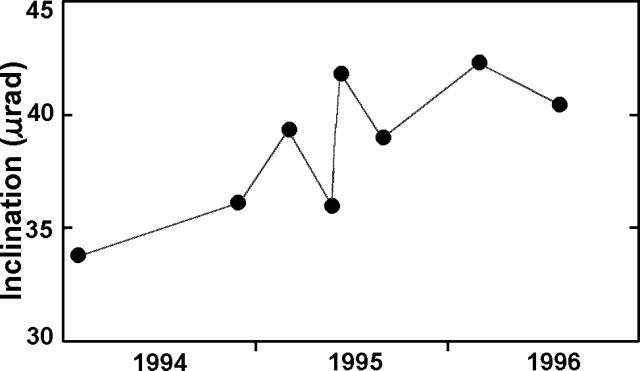Report on Irazu (Costa Rica) — January 1997
Bulletin of the Global Volcanism Network, vol. 22, no. 1 (January 1997)
Managing Editor: Richard Wunderman.
Irazu (Costa Rica) Minor seismicity; no significant tilt in late 1996
Please cite this report as:
Global Volcanism Program, 1997. Report on Irazu (Costa Rica) (Wunderman, R., ed.). Bulletin of the Global Volcanism Network, 22:1. Smithsonian Institution. https://doi.org/10.5479/si.GVP.BGVN199701-345060
Irazu
Costa Rica
9.979°N, 83.852°W; summit elev. 3436 m
All times are local (unless otherwise noted)
Situated 5 km SW of the crater, the local seismic station (IRZ2) registered 18 local events during September 1995. Although a survey of the tilt network that extends 3.5 km S of the crater has detected no significant tilt since 1994, three of five electronic inclinometers measured an average tilt of 5.6 µrad/year since 1994 (figure 10).
 |
Figure 10. Tilt at Irazú from an electronic inclinometer ("dry-tilt" at station Torres) during 26 January 1994-1 August 1996. Measurement times are shown as dots. Courtesy of OVSICORI-UNA. |
Geological Summary. The massive Irazú volcano in Costa Rica, immediately E of the capital city of San José, covers an area of 500 km2 and is vegetated to within a few hundred meters of its broad summit crater complex. At least 10 satellitic cones are located on its S flank. No lava effusion is known since the eruption of the Cervantes lava flows from S-flank vents about 14,000 years ago, and all known Holocene eruptions have been explosive. The focus of eruptions at the summit crater complex has migrated to the W towards the main crater, which contains a small lake. The first well-documented eruption occurred in 1723, and frequent explosive eruptions have occurred since. Ashfall from the last major eruption during 1963-65 caused significant disruption to San José and surrounding areas. Phreatic activity reported in 1994 may have been a landslide event from the fumarolic area on the NW summit (Fallas et al., 2018).
Information Contacts: E. Fernández, E. Duarte, V. Barboza, R. Van der Laat, E. Hernandez, M. Martinez, and R. Sáenz, Observatorio Vulcanológico y Sismológico de Costa Rica, Universidad Nacional (OVSICORI-UNA), Apartado 86-3000, Heredia, Costa Rica.

